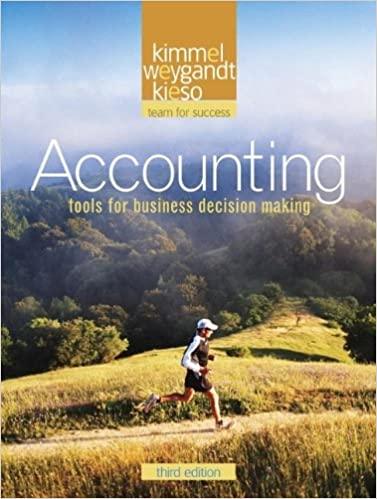Stein Hardware Store completed the following merchandising transactions in the month of May. At the beginning of
Question:
Stein Hardware Store completed the following merchandising transactions in the month of May. At the beginning of May, Stein’s ledger showed Cash of $8,000 and Common Stock of $8,000.
May 1 Purchased merchandise on account from Hilton Wholesale Supply for $8,000, terms 2/10, n/30.
2 Sold merchandise on account for $4,400, terms 3/10, n/30. The cost of the merchandise sold was $3,300.
5 Received credit from Hilton Wholesale Supply for merchandise returned $200.
9 Received collections in full, less discounts, from customers billed on May 2.
10 Paid Hilton Wholesale Supply in full, less discount.
11 Purchased supplies for cash $900.
12 Purchased merchandise for cash $2,700.
15 Received $230 refund for return of poor-quality merchandise from supplier on cash purchase.
17 Purchased merchandise from Northern Distributors for $2,500, terms 2/10, n/30.
19 Paid freight on May 17 purchase $250.
24 Sold merchandise for cash $5,400. The cost of the merchandise sold was $4,020.
25 Purchased merchandise from Toolware Inc. for $800, terms 3/10, n/30.
27 Paid Northern Distributors in full, less discount.
29 Made refunds to cash customers for returned merchandise $124. The returned merchandise had cost $90.
31 Sold merchandise on account for $1,280, terms n/30. The cost of the merchandise sold was $830.
Stein Hardware’s chart of accounts includes Cash, Accounts Receivable, Merchandise Inventory, Supplies, Accounts Payable, Common Stock, Sales, Sales Returns and Allowances, Sales Discounts, and Cost of Goods Sold.
Instructions
(a) Journalize the transactions using a perpetual inventory system.
(b) Post the transactions to T accounts. Be sure to enter the beginning cash and common stock balances.
(c) Prepare an income statement through gross profit for the month of May 2010.
(d) Calculate the profit margin ratio and the gross profit rate. (Assume operating expenses were $1,400.)
Common stock is an equity component that represents the worth of stock owned by the shareholders of the company. The common stock represents the par value of the shares outstanding at a balance sheet date. Public companies can trade their stocks on...
Step by Step Answer:

Accounting Tools For Business Decision Making
ISBN: 9780470377857
3rd Edition
Authors: Paul D. Kimmel





